Catahoula Images
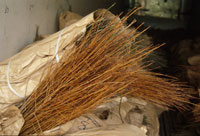 |
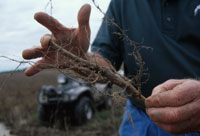 |
|
Seedlings Bottomland hardwood seedlings, such as nuttall, willow and water oaks, bald cypress and green ash, were planted by machine (shown here) and by hand this spring by Environmental Synergy, Inc. (ESI), under contract to American Electric Power. ESI planted seedlings on about 2,500 acres this spring as the first phase of AEP's Catahoula Reforestation Project in east-central Louisiana. The project site is part of an 18,372-acre site acquired by AEP (10,257 acres) and the U.S. Fish & Wildlife Service (USFWS) (8,115 acres) this spring. The site is just north of Catahoula Lake and the Catahoula National Wildlife Refuge (NWR), about 35 miles northeast of Alexandria, La. ESI will complete its plantings on an additional 8,000 acres by the spring of 2002. USFWS will manage the entire 18,372-acre site as part of the Catahoula NWR. |
Roots Only nursery stock with healthy root systems is used in American Electric Power's Catahoula Reforestation Project in east-central Louisiana about 35 miles northeast of Alexandria, La. The project is located just north of Catahoula Lake and the Catahoula National Wildlife Refuge. The planting project will restore bottomland hardwood trees to about 10,500 acres that had been cleared for farming. As the seedlings grow, they will absorb carbon dioxide, a greenhouse gas. As such, the project will sequester (capture) CO2 to offset such releases from the combustion of fossil fuels. |
| Download
300 dpi TIFF (7.5 mb) Download 300 dpi JPEG (286 kb) Download 300 dpi PDF (743 KB) |
Download
300 dpi TIFF (7.5 mb) Download 300 dpi JPEG (152 kb) Download 300 dpi PDF (426 KB) |
 |
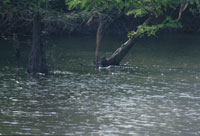 |
|
Bayou Beautiful cypress trees and water oaks, as well as bottomland hardwood species, grace the Catahoula Lake region of east-central Louisiana. American Electric Power of Columbus, Ohio, is restoring native trees on about 10,500 acres in its Catahoula Reforestration Project. The entire 18,372-acre site is to be managed by the U.S. Fish & Wildlife Service (USFWS) as part of the Catahoula National Wildlife Refuge. The entire site was acquired by AEP (10,257 acres) and USFWS (8,115 acres) this spring for multiple benefits. Natural habitat will be restored, and the new tree growth provide a large carbon sequestration site. As the seedlings grow, they will absorb and store carbon dioxide, a greenhouse gas, released by combustion of fossil fuels and other activities. |
Gator An alligator glides by the base of a tree in a small body of water in the Catahoula Lake area of east-central Louisiana. American Electric Power of Columbus, Ohio, is in the midst of a reforestation project on portions of an 18,372-acre site just north of Catahoula Lake and the Catahoula National Wildlife Refuge. The project is intended to restore bottomland hardwoods to an area that had been cleared for farming and has lain fallow for several years. |
| Download
300 dpi TIFF (7.5 mb) Download 300 dpi JPEG (306 kb) Download 300 dpi PDF (785 KB) |
Download
300 dpi TIFF (7.5 mb) Download 300 dpi JPEG (249 kb) Download 300 dpi PDF (654 KB) |
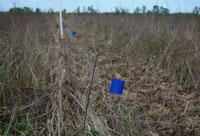 |
 |
|
Flags Blue flags mark where hardwood seedlings were planted this spring as part of the Catahoula Reforestation Project in east-central Louisiana, about 35 miles northeast of Alexandria. Approximately 302 seedlings were planted per acre. American Electric Power's planting contractor Environmental Synergy, Inc., of Atlanta, planted about 2,500 acres this spring. An additional 8,000 acres are to be planted with trees by the spring of 2002. |
Catahoula
Reforestation Map
|
| Download
300 dpi TIFF (7.5 mb) Download 300 dpi JPEG (299 kb) Download 300 dpi PDF (757 KB) |
Download
300 dpi TIFF (961 kb) Download 300 dpi GIF(28 kb) Download 300 dpi PDF (530 KB) |
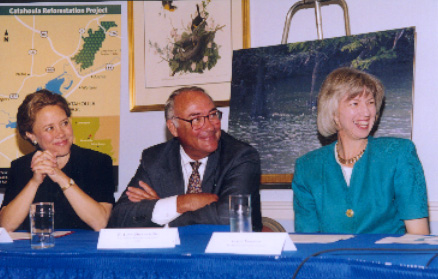 |
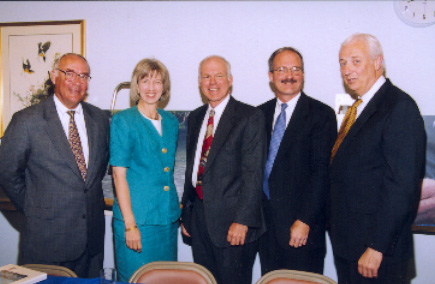 |
|
AEP chairman E. Linn Draper Jr. shares a happy moment at the news conference with U.S. Senator Mary Landrieu (D-La., left) and U.S. Secretary of the Interior Gale Norton (right).
|
Participating in the news conference, from left: AEP chairman E. Linn Draper Jr.; U.S. Secretary of the Interior Gale Norton; John Turner, president of The Conservation Fund; Sam D. Hamilton, U.S. Fish and Wildlife Service Southeast Region director, Atlanta; and U.S. Rep. John Cooksey of Louisiana (R-5th).
|
| Download 72 dpi JPEG (67 kb) | Download 72 dpi JPEG(57 kb) |